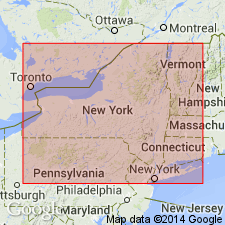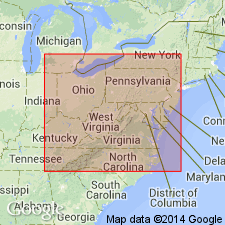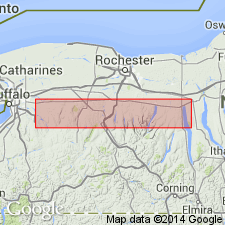
- Usage in publication:
-
- Hamilton group
- Modifications:
-
- Named
- Dominant lithology:
-
- Shale
- Sandstone
- AAPG geologic province:
-
- Appalachian basin
Summary:
Named Hamilton group for Hamilton, Madison Co., NY. Consists of shales of dark-blue and olive colors and sandstone. West Hamilton is locality where the group is well characterized. The Hamilton underlies the Moscow shales and overlies the Skaneateles shales. Near Cayuga Lake it is separated from the Moscow by encrinal limestone. The Hamilton is of Middle Devonian age.
Source: GNU records (USGS DDS-6; Reston GNULEX).

- Usage in publication:
-
- Hamilton Group*
- Modifications:
-
- Areal extent
- AAPG geologic province:
-
- Appalachian basin
Summary:
Hamilton Group extended into eastern OH, from NY, PA, and WV.
Source: GNU records (USGS DDS-6; Reston GNULEX).

- Usage in publication:
-
- Hamilton Group*
- Modifications:
-
- Overview
- AAPG geologic province:
-
- Appalachian basin
Summary:
Author follows usage of Baird (1979). Hamilton Group shown on figure 2 as including (ascending) Ludlowville Formation (with its Wanakah Shale Member and Jaycox Shale Member) and Moscow Formation (with its Tichenor Limestone Member, Deep Run Shale Member, Menteth Limestone Member, Kashong Shale Member, and Windom Shale Member).
Source: GNU records (USGS DDS-6; Reston GNULEX).
For more information, please contact Nancy Stamm, Geologic Names Committee Secretary.
Asterisk (*) indicates published by U.S. Geological Survey authors.
"No current usage" (†) implies that a name has been abandoned or has fallen into disuse. Former usage and, if known, replacement name given in parentheses ( ).
Slash (/) indicates name conflicts with nomenclatural guidelines (CSN, 1933; ACSN, 1961, 1970; NACSN, 1983, 2005, 2021). May be explained within brackets ([ ]).

